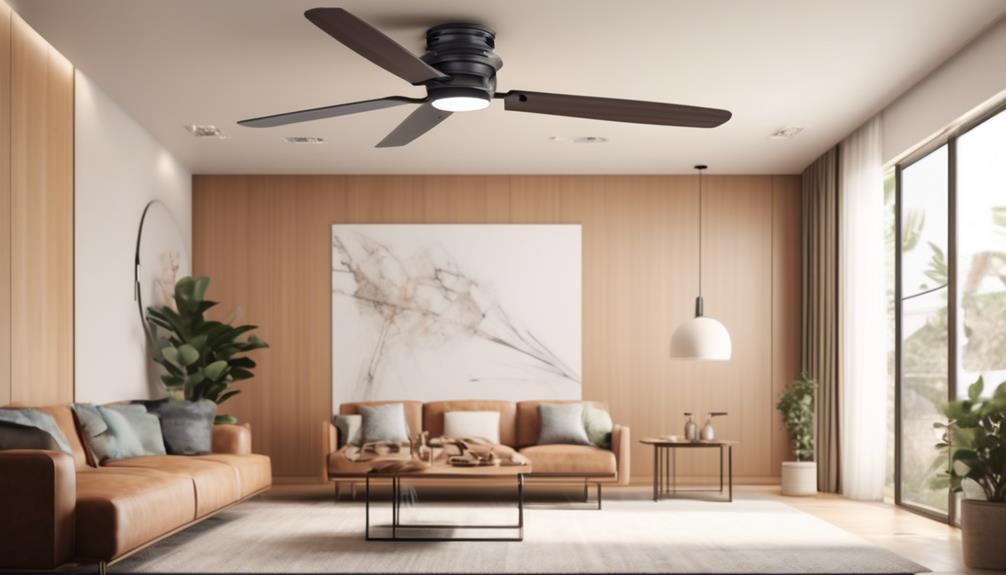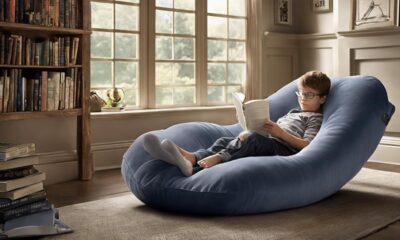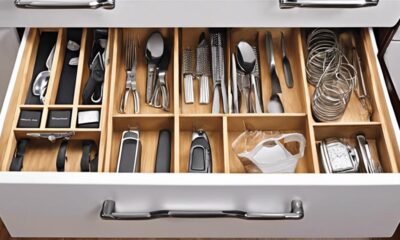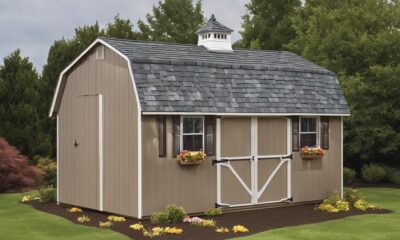Appliances
What Is a Ceiling Fan Receiver
2025

Ceiling fan receivers serve as the maestro for your ceiling fan, seamlessly directing its every move. These crucial elements enable you to remotely adjust the fan’s speed, direction, and lighting, ensuring smooth operation.
In this article, we will explore the ins and outs of ceiling fan receivers – how they work, their key functions, and their installation process. We will also delve into their compatibility with different ceiling fan models and the benefits they bring to your daily life.
So, if you've ever wondered what makes your ceiling fan tick and how you can enhance its functionality, sit back and let us be your guide through the world of ceiling fan receivers.
Key Takeaways
- Ceiling fan receivers act as intermediaries between the fan and remote control, allowing for remote control operation of fan functions.
- Proper installation and compatibility of ceiling fan receivers are important for functionality and troubleshooting common issues.
- Ceiling fan receivers offer benefits such as remote control operation, enhanced functionality with smart home systems, and customization options.
- Ceiling fan receivers promote energy efficiency by allowing precise control over fan speed and lighting levels, optimizing energy consumption.
The Basics of a Ceiling Fan Receiver
The ceiling fan receiver is a crucial component that allows for the remote control operation of the fan's various functions. It acts as the intermediary between the fan and the remote control, receiving signals from the remote and translating them into commands that the fan can understand. Troubleshooting common issues with ceiling fan receivers is an essential skill for any fan owner.
If you find that your remote control isn't working, the first step is to check the batteries. Ensure they're properly inserted and fully charged. If the batteries are fine, try resetting the receiver by turning off the power to the fan for a few minutes and then turning it back on.
If these steps don't solve the issue, it may be necessary to replace the receiver. Upgrading your ceiling fan receiver can provide enhanced functionality, such as compatibility with smart home systems or the ability to control the fan using a mobile app. When upgrading, make sure to choose a receiver that's compatible with your fan's make and model.
Installing the new receiver is a relatively straightforward process, but it's always a good idea to consult the manufacturer's instructions for specific guidance.
How a Ceiling Fan Receiver Works

To understand the functioning of a ceiling fan receiver, it's important to grasp its role as the central hub that translates remote control signals into commands for the fan. The receiver acts as the bridge between the fan and the remote control, allowing users to conveniently operate their ceiling fans from a distance.
The receiver is typically located within the canopy of the fan, where it receives the signals from the remote control. These signals, which are sent via radio frequency or infrared, are then decoded by the receiver and translated into specific commands for the fan. These commands can include adjusting the fan speed, changing the direction of rotation, and controlling the light settings.
The receiver also enables the remote control capabilities of the fan, allowing users to control multiple functions with just a press of a button. This convenience is especially valuable in situations where the fan is installed in high ceilings or hard-to-reach areas.
When troubleshooting common issues with a ceiling fan receiver, it's important to check the batteries in the remote control and ensure that they're properly inserted and functional. Additionally, ensuring that the receiver is securely connected to the fan's wiring and that all connections are properly tightened can help resolve any connectivity issues. If problems persist, it may be necessary to consult the manufacturer's instructions or seek professional assistance.
Key Functions of a Ceiling Fan Receiver
One of the key functions of a ceiling fan receiver is its ability to decode and translate remote control signals into specific commands for the fan. This allows users to conveniently control the fan speed, direction, and lighting from a distance. The receiver acts as the intermediary between the remote control and the fan itself, ensuring that the desired commands are executed accurately.
In addition to decoding and translating signals, a ceiling fan receiver also plays a crucial role in enabling the fan's various key features. It allows for the adjustment of fan speed, allowing users to set it to their preferred level of comfort. It also enables the change of fan direction, which can be useful in both summer and winter months to either create a cooling breeze or redistribute warm air. Furthermore, the receiver facilitates the control of the fan's lighting, allowing users to adjust brightness or turn it on and off.
When troubleshooting issues with a ceiling fan, it's important to consider the receiver as a potential source of the problem. If the fan is unresponsive to remote control commands, it may be due to a malfunctioning receiver. In such cases, it's advisable to check the receiver's connections, replace the batteries in the remote control, or reset the receiver if necessary.
Proper maintenance and care of the receiver can help ensure smooth operation and extend the lifespan of the ceiling fan.
Installation and Compatibility of Ceiling Fan Receivers

Installing a ceiling fan receiver is an essential step in ensuring proper functionality and compatibility with the fan's remote control system.
When it comes to troubleshooting common issues with ceiling fan receivers, there are a few common problems that may arise. One of the most common issues is the receiver not responding to the remote control commands. This can often be resolved by checking the batteries in the remote and replacing them if necessary.
Another common issue is the receiver not receiving signals from the remote control. In this case, it's important to check the alignment of the receiver and the remote, as well as ensuring that there are no obstructions blocking the signal.
If you're looking to upgrade an existing ceiling fan to include a receiver, it's important to first check the compatibility of the fan with a receiver. Not all ceiling fans are designed to be compatible with receivers, so it's important to do some research before making a purchase.
Once you have confirmed compatibility, the installation process is relatively straightforward. It involves disconnecting the existing wiring and control system, and then connecting the new receiver according to the manufacturer's instructions.
Benefits of Using a Ceiling Fan Receiver
When utilizing a ceiling fan receiver, users can experience a range of benefits that enhance the overall functionality and control of their ceiling fan system. Here are some of the advantages of using a ceiling fan receiver:
- Energy efficiency: A ceiling fan receiver allows users to optimize energy consumption by providing precise control over fan speed and lighting levels. This helps to reduce energy waste and lower electricity bills.
- Remote control functionality: With a ceiling fan receiver, users can conveniently control their ceiling fan system from anywhere in the room using a remote control. This eliminates the need for manual adjustments and enhances user comfort.
- Enhanced customization: Ceiling fan receivers offer various customization options, such as adjustable fan speeds, timer settings, and dimmable lighting. This allows users to create the perfect ambiance and tailor the fan system to their preferences.
- Improved convenience: By integrating a ceiling fan receiver into their system, users can enjoy the convenience of controlling both the fan and lighting functions from a single device. This eliminates the need for multiple switches or remotes, streamlining the user experience.
- Compatibility with smart home systems: Many ceiling fan receivers are compatible with smart home systems, allowing users to integrate their fan system with other smart devices and control them through voice commands or mobile apps. This adds an extra level of convenience and automation to the user's home.
Can a Faulty Ceiling Fan Receiver Cause the Need for Replacement?
Yes, a faulty ceiling fan receiver can indeed cause the need for replacement. The receiver is a crucial component that controls the fan’s speed and direction. If it malfunctions, it can lead to electrical issues and potential safety hazards. This can increase the ceiling fan replacement frequency significantly.
Frequently Asked Questions
How Much Power Does a Ceiling Fan Receiver Consume?
When it comes to power consumption, the ceiling fan receiver is an important factor to consider. Its energy efficiency plays a crucial role in determining the overall energy usage of the ceiling fan.
The amount of power a ceiling fan receiver consumes can vary depending on the specific model and features. However, manufacturers strive to design receivers that are energy-efficient to minimize power consumption and promote sustainability.
Can a Ceiling Fan Receiver Be Controlled Remotely?
Yes, a ceiling fan receiver can be controlled remotely, providing convenience and ease of use. With a remote control, you can adjust the fan speed, change the direction of the blades, and even control the light settings from the comfort of your couch. This feature allows you to effortlessly create the desired atmosphere in your room without having to get up.
However, if you encounter any issues with the remote control, troubleshooting common problems such as battery replacement or signal interference can help resolve the situation.
Are Ceiling Fan Receivers Compatible With All Types of Ceiling Fans?
Ceiling fan receivers vary in compatibility with different types of ceiling fans. While some receivers may be designed to work with a wide range of fan models, others may be specifically tailored for certain brands or models.
It's important to ensure that the receiver you choose is compatible with your specific ceiling fan to ensure seamless integration and optimal performance.
Familiarizing yourself with the different types of ceiling fan receivers available can help you make an informed decision based on your specific needs and preferences.
Can a Ceiling Fan Receiver Be Installed on an Existing Ceiling Fan?
Adding a ceiling fan receiver to an existing fan can offer numerous benefits. It allows for remote control operation, providing convenience and ease of use.
Installing a receiver is a straightforward process. First, turn off the power to the fan. Next, remove the fan's canopy cover to access the wiring. Connect the receiver to the existing wiring, following the manufacturer's instructions. Finally, reassemble the fan and enjoy the added functionality of a ceiling fan receiver.
Are There Any Safety Precautions to Consider When Installing a Ceiling Fan Receiver?
When installing a ceiling fan receiver, it's important to consider safety precautions.
Common installation mistakes can lead to electrical hazards or damage to the fan.
To ensure safety, always turn off the power supply before beginning the installation process.
Additionally, double-check that the receiver is compatible with your specific fan model.
Follow the manufacturer's instructions carefully and avoid over-tightening screws or using incorrect wiring connections.
Conclusion
In conclusion, the ceiling fan receiver is a crucial component that allows for the remote control operation of a ceiling fan. It receives signals from the remote control and translates them into commands that control the fan's speed, direction, and lighting.
By understanding the basic principles and functions of a ceiling fan receiver, homeowners can make informed decisions when it comes to installation and compatibility.
Investing in a ceiling fan receiver offers convenience, comfort, and efficient energy usage.
- About the Author
- Latest Posts
Meet Bethia, the visionary designer at ByRetreat who brings a touch of magic to every remote workspace she creates. With a boundless imagination and an eye for beauty, Bethia is passionate about transforming ordinary spaces into extraordinary havens of creativity and comfort.
Bethia possesses a unique talent for envisioning the perfect combination of furniture, colors, and textures that harmonize seamlessly in a room. She understands that selecting furniture goes beyond mere functionality; it’s about curating pieces that evoke a sense of style and sophistication while enhancing the overall ambiance.
Garage Door Opener
LiftMaster Garage Door Opener Warranty: A Complete Guide
Prepare for peace of mind with the LiftMaster Garage Door Opener Warranty – discover its protection for your home's guardian…

Picture your garage door opener as the quiet protector of your house, consistently opening and closing day after day. But what happens when this protector faces a malfunction? That’s when the LiftMaster Garage Door Opener Warranty comes into play, providing peace of mind.
But what exactly does this warranty entail? Let's uncover the intricacies of this warranty program together, exploring its coverage details, warranty period, claim process, exclusions, limitations, and even extended warranty options.
Let's shed light on how this warranty can safeguard your daily comings and goings.
Key Takeaways
- LiftMaster's warranty covers defects, ensuring quality assurance for garage door openers.
- Warranty period starts from purchase date, with tailored coverage for parts and accessories.
- Contact customer support for claims, providing proof of purchase for evaluation.
- Explore extended warranty options for added protection against unexpected repair costs.
Coverage Details
Covering a comprehensive range of aspects, the LiftMaster Garage Door Opener warranty offers protection against defects in workmanship and materials. This warranty, provided by LiftMaster, a brand under Chamberlain Group LLC, ensures that your garage door product is backed by quality assurance.
With this warranty, you can feel confident in the control and access to your garage door with the myQ technology. In case of any issues with the product, the warranty covers repair or replacement of defective parts at no additional cost to you. This comprehensive coverage extends to various parts and accessories, guaranteeing a worry-free experience.
Warranty Period

Typically, the warranty period for LiftMaster Garage Door Openers commences from the date of purchase, ensuring coverage for defects in materials and workmanship during the specified timeframe. LiftMaster, a global leader in intelligent access control solutions, offers warranties tailored to different parts and accessories of their openers. This ensures comprehensive protection for consumers against faulty components.
Customers leveraging the myQ ecosystem that delivers seamless remote control capabilities can rest assured that defective parts fall under the specified warranty coverage. Understanding the warranty period is crucial for making informed warranty claims, and utilizing the myQ app further enhances this process by providing a convenient platform for managing warranty-related issues.
It's essential to note that the warranty period not only safeguards consumers' purchases but also grants them specific legal rights, ensuring a secure and reliable ownership experience.
Claim Process
To initiate the warranty claim process for your LiftMaster Garage Door Opener, reach out to customer support or authorized dealers with your sales receipt/invoice and proof of purchase for verification. If you encounter any issues with your registered product, it's crucial to provide the necessary documentation to ensure a smooth process.
Warranty Claim Process Table:
| Step | Details |
|---|---|
| Contact Support | Reach out to customer support or dealers. |
| Documentation | Provide sales receipt and proof of purchase. |
| Warranty Evaluation | Assess if the issue falls under warranty coverage. |
Exclusions and Limitations

When considering the coverage provided by the LiftMaster Garage Door Opener warranty, it's essential to understand the specific exclusions and limitations set forth by the manufacturer. It's crucial to be aware of what may not be covered to avoid any surprises when seeking warranty service.
Here are some key exclusions and limitations to keep in mind:
- Failure to provide reasonable and necessary maintenance may void the warranty.
- Improper installation, operation, or care leading to damage(s) isn't covered.
- Problems caused by interference or issues with the garage door hardware are excluded.
- The warranty doesn't cover incidental or special damages, including the inability to use the garage door opener.
Understanding these exclusions and limitations is vital to ensure that you can make the most of the warranty coverage provided for your LiftMaster Garage Door Opener. Be sure to adhere to the manufacturer's guidelines and requirements to prevent any complications regarding warranty claims.
Extended Warranty Options
Considering the exclusions and limitations of the LiftMaster Garage Door Opener warranty, exploring the extended warranty options offered can provide added protection and coverage for customers. LiftMaster's extended warranty options go beyond the standard warranty period, offering peace of mind by safeguarding against unexpected repair costs.
Customers can select from a range of extended warranty plans tailored to their specific needs and preferences, ensuring additional coverage for their garage door opener. These extended warranties commonly include comprehensive coverage for parts, labor, and other vital components of the garage door opener.
Frequently Asked Questions
How Long Is the Warranty on a Liftmaster Garage Door Opener?
The warranty on a LiftMaster garage door opener typically lasts for 1 year for accessories and 5 years for parts. Warranty periods may vary depending on the specific model.
Coverage starts from the purchase date and guards against workmanship and material defects. To file a claim, you might need to show the sales receipt and proof of purchase.
It's crucial to understand the warranty details for your particular LiftMaster garage door opener model.
How Do I Contact Liftmaster Customer Service?
We contact LiftMaster customer service by calling 866-337-1631 or emailing info@localgaragedoors.co. They offer professional and prompt support for all inquiries, including technical guidance, warranty claims, and product information.
The representatives are knowledgeable about LiftMaster products and services. For a seamless experience, reach out to customer service for any questions or concerns you may have.
What Voids a Garage Door Warranty?
Not following maintenance instructions, using unauthorized parts, or making unapproved modifications can void a garage door warranty. Abuse, improper installation, or neglect can also nullify coverage.
Unauthorized repairs and misuse may lead to warranty voiding. Non-compliance with operational guidelines or care requirements can result in voided warranties.
Any alterations without approval could render the warranty invalid. It's crucial to adhere strictly to the terms to maintain warranty coverage.
How Long Is a Typical Garage Door Warranty?
We've got your answer! Typically, a garage door warranty spans from 1 to 5 years, starting from the purchase date of your opener. The duration can vary depending on the specific parts covered.
Details regarding warranty coverage are usually outlined in the product manual. Remember, for any warranty claims or service needs, it's crucial to reach out to the support team or authorized dealers.
Conclusion
In conclusion, the LiftMaster Garage Door Opener Warranty offers peace of mind for customers by providing coverage for defects in materials and workmanship.
Remember to follow all installation, operation, and maintenance instructions to ensure warranty validity.
And remember, when it comes to protecting your investment, the early bird catches the worm. So make sure to purchase from authorized sellers for maximum warranty benefits.
- About the Author
- Latest Posts
Introducing Ron, the home decor aficionado at ByRetreat, whose passion for creating beautiful and inviting spaces is at the heart of his work. With his deep knowledge of home decor and his innate sense of style, Ron brings a wealth of expertise and a keen eye for detail to the ByRetreat team.
Ron’s love for home decor goes beyond aesthetics; he understands that our surroundings play a significant role in our overall well-being and productivity. With this in mind, Ron is dedicated to transforming remote workspaces into havens of comfort, functionality, and beauty.
Garage Door Opener
What Makes Buildmark Garage Door Opener Stand Out?
Keen on discovering the key features that set the BuildMark Garage Door Opener apart from the rest?

When it comes to garage door openers, the BuildMark model stands out like a shiny gem among the many choices available. Its unique features and customizable components make it a cut above the rest.
But what exactly makes this opener stand out among the competition? Let's explore the intricate details that make the BuildMark Garage Door Opener a top choice for homeowners seeking quality and reliability in their garage door operation.
Key Takeaways
- MyQ technology enables remote monitoring and control.
- Durable components ensure smooth, quiet operation.
- Customizable options for personalized style and function.
- Exceptional customer support and warranty for peace of mind.
Innovative Features and Technology
When it comes to innovative features and cutting-edge technology, the BuildMark garage door opener stands out as a top contender in the market. One standout feature is the integration of MyQ technology, allowing for remote monitoring and control of your garage door from anywhere. This means no more worrying about whether you left the garage door open or not – you can check and close it with ease using your smartphone.
The built-in Wi-Fi connectivity is another game-changer, enabling seamless integration with smart home systems for a more connected and convenient lifestyle.
Additionally, the battery backup feature ensures that your garage door will still operate during power outages, providing both convenience and security. The Security+ 2.0 technology adds another layer of protection by encrypting signals to prevent hacking and unauthorized access.
Lastly, the timer-to-close feature automatically closes the garage door after a preset amount of time, offering peace of mind and ensuring that your belongings are safe and secure. The BuildMark garage door opener truly redefines what a garage door opener can do.
Superior Reliability and Performance

BuildMark garage door openers demonstrate unmatched reliability and performance in every aspect of their design and operation. Engineered with durable components and advanced technology, these openers deliver a smooth and quiet operation that enhances the overall performance of your garage door system. The use of high-quality materials ensures long-lasting performance and minimal maintenance, making BuildMark openers a dependable choice for homeowners.
What sets BuildMark apart isn't just its reliability, but also its advanced safety features that guarantee secure and worry-free operation. Knowing that your garage door opener is equipped with the latest safety mechanisms provides peace of mind for you and your family. Additionally, the focus on efficiency and convenience means that BuildMark openers will continue to provide reliable operation for years to come.
When it comes to reliability and performance, BuildMark garage door openers stand out as a top choice, offering durability, advanced technology, and safety features that prioritize your peace of mind.
User-Friendly Design and Operation
With a user-friendly design that prioritizes ease of operation, BuildMark garage door openers offer convenient controls for seamless functionality. The easy-to-use controls make operating the garage door opener a breeze, allowing users to open and close their garage doors with minimal effort. The advanced technology integrated into the opener ensures smooth and quiet door movement, enhancing the overall user experience. Additionally, users have the flexibility to program and customize settings such as speed, force, and lighting options to suit their preferences, adding a personalized touch to their garage door operation.
Furthermore, safety is paramount with BuildMark garage door openers, as they come equipped with features like automatic reverse and obstacle detection to ensure secure and worry-free operation. Homeowners can trust in the reliability and durability of BuildMark products, knowing that they're designed to provide long-lasting performance. Say goodbye to complicated garage door openers and embrace the liberation of effortless operation with BuildMark.
Customization Options for Every Need

Discover an array of customization options tailored to meet every need with BuildMark garage door openers. Whether you prefer a classic White, a warm Almond, or a subtle Desert Tan, there are various colors available to match your personal style.
Not only can you choose from custom panel options like Raised Colonial, Raised Ranch, or Recessed Colonial to complement your home's aesthetic, but you can also add decorative hardware such as handles, straps, and plastic kits for a personalized touch.
Enhance the overall look with decorative window choices like clear, obscure, or satin glass options, or opt for snap-in window designs to further customize the appearance of your garage door opener. With BuildMark, you have the freedom to create a unique and tailored look that reflects your individual taste and elevates the curb appeal of your home.
Exceptional Customer Support and Warranty
For those seeking peace of mind and reliable support, the exceptional customer service and warranty provided with BuildMark garage door openers are unparalleled in the industry. When you choose a BuildMark garage door opener, you not only get a high-quality product but also access to outstanding customer support and a comprehensive warranty for added assurance.
To give you a better idea of the exceptional customer support and warranty offered with BuildMark garage door openers, take a look at the table below:
| Customer Support | Warranty Coverage | Registration Process |
|---|---|---|
| Access to glossary of terms | Limited warranty with proof of purchase required | Register opener for warranty coverage and product updates |
| Details on services | Encouragement to contact dealer or Raynor for claims | May involve product inspection by Raynor |
| Information on becoming a dealer | Specific legal rights granted | State-specific customer rights may apply |
With BuildMark, you are not just purchasing a garage door opener; you are investing in exceptional support and peace of mind.
Frequently Asked Questions
Who Makes the Best Garage Door Openers?
When it comes to garage door openers, various brands stand out for their reliability and features. LiftMaster, Chamberlain, Genie, and Craftsman are popular choices known for their performance and innovation.
Factors like horsepower, drive type, and smart technology play a crucial role in selecting the best garage door opener for your needs. It's essential to consider these aspects to ensure you get a reliable and efficient product that meets your requirements.
What Is the Average Life Expectancy of a Garage Door Opener?
When it comes to the average life expectancy of a garage door opener, factors like usage frequency, maintenance, and installation quality play key roles. Typically lasting around 10 to 15 years, modern models often offer warranties ranging from 5 to 10 years.
Regular upkeep, lubrication, and professional check-ups can prolong its lifespan. Upgrading to a newer model with advanced features can also boost reliability and longevity.
How Much Horsepower Do I Need for a 2 Car Garage Door?
When choosing a garage door opener for a 2-car garage, it's crucial to get the right horsepower for smooth operation. Factors like door weight and size play a key role. Oversized horsepower can stress the system.
Consult with professionals or follow manufacturer recommendations. Need help deciding? Just ask, and we'll guide you to the perfect choice. Your garage door deserves the best, and we've got you covered!
Is It Worth Upgrading Garage Door Opener?
Upgrading our garage door opener is definitely worth it. Improved security, quieter operation, advanced safety features, and convenient remote access are all compelling reasons to make the switch.
Not only does it bring peace of mind, but it also adds flexibility to our daily routine. Investing in a BuildMark garage door opener ensures long-term reliability and durability, making it a smart choice for the future of our home.
Conclusion
In conclusion, the BuildMark Garage Door Opener truly goes the extra mile when it comes to quality, customization, and performance. With features that make it stand out from the competition like a sore thumb, this opener is a top choice for homeowners looking for durability and style.
So why settle for the same old garage door opener when you can have one that truly stands head and shoulders above the rest? Choose BuildMark for a garage door opener that's a cut above the rest!
- About the Author
- Latest Posts
Introducing Ron, the home decor aficionado at ByRetreat, whose passion for creating beautiful and inviting spaces is at the heart of his work. With his deep knowledge of home decor and his innate sense of style, Ron brings a wealth of expertise and a keen eye for detail to the ByRetreat team.
Ron’s love for home decor goes beyond aesthetics; he understands that our surroundings play a significant role in our overall well-being and productivity. With this in mind, Ron is dedicated to transforming remote workspaces into havens of comfort, functionality, and beauty.
Garage Door Opener
What Are the Benefits of a Bicycle Garage Door Opener?
Harness the power of convenience with a bicycle garage door opener, transforming your cycling routine with effortless access – discover the hidden benefits that await!

Have you ever thought about how a bicycle garage door opener could transform your cycling routine?
The benefits extend beyond mere convenience, offering a seamless way to access your garage effortlessly.
But that's just the beginning.
By exploring the various advantages this innovative device brings to cyclists, you will discover a whole new dimension to your riding experience.
Key Takeaways
- Seamless and hands-free operation for quick bike access.
- Enhanced security features with remote access control.
- Space optimization in the garage for easy bike storage.
- Integration with smart home technology for remote control and automation.
Enhanced Convenience and Accessibility
Bicycle garage door openers revolutionize the way cyclists access their garages by providing seamless and hands-free operation. These innovative garage door openers allow cyclists to effortlessly open and close their garage doors without the need to dismount from their bikes. With wireless capabilities, users can operate the garage door from a distance, offering unparalleled convenience.
The compatibility of these garage door openers with a wide range of garage doors makes them a versatile accessory for cyclists. The ability to open the garage door remotely not only enhances convenience but also adds an extra layer of security by reducing the need to leave bikes unattended outside. Cyclists can now enjoy a liberated cycling experience knowing that their garage is easily accessible and secure with the use of a bicycle garage door opener.
Improved Security Features for Peace of Mind

Enhancing garage security through advanced features ensures peace of mind for cyclists utilizing a bicycle garage door opener. The improved security features of a bicycle garage door opener provide a sense of liberation and confidence in the safety of your belongings.
Here are some key elements that contribute to the heightened security:
- Secure Access Control: The opener prevents unauthorized entry, keeping your garage and valuables safe.
- Remote Operation: Enjoy the convenience of opening and closing your garage door while on your bike, adding an extra layer of security.
- Wireless Capability: Operate the garage door from a safe distance, ensuring you can control access even when away from home.
- Wide Compatibility: Seamless integration with various garage doors enhances security by providing a tailored fit for your setup.
These security features, combined with the opener's durable and weather-resistant design, offer reliable protection against potential threats, allowing you to focus on your cycling adventures without worry.
Efficient Storage and Space Optimization
With the focus now shifting towards efficient storage and space optimization, the benefits of a bicycle garage door opener extend beyond just enhanced security features. A bicycle garage door opener helps maximize space utilization in a garage by efficiently storing and organizing bikes.
Designed specifically for bicycles, this opener allows easy access and storage without the need for manual lifting or awkward storage solutions, providing a convenient solution for daily use. By simply pressing a button, users can open and close the garage door swiftly, saving time and effort.
This efficient storage solution not only keeps bikes secure but also encourages their regular use, promoting an active lifestyle. With a bicycle garage door opener, users can make the most of their garage space, ensuring that their bikes are stored safely and conveniently, ready for their next adventure.
Seamless Integration With Smart Home Technology

Integrating a bicycle garage door opener with smart home technology allows for seamless control of the garage door remotely through various devices and platforms. This integration offers a range of benefits for users seeking convenience and security in managing their garage access.
Here are some key advantages:
- Remote Operation: Easily control the garage door using smartphone apps, voice commands, or smart home hubs.
- Scheduled Automation: Set automatic opening and closing times to enhance security and provide peace of mind.
- Global Accessibility: Monitor and control garage access from anywhere in the world, ensuring constant oversight.
- Enhanced Home Automation: Connect the garage door opener to other smart devices for improved overall home automation and security features.
Enhanced Cycling Experience and Lifestyle Benefits
Having a bicycle garage door opener not only provides cyclists with quick and convenient access to their bikes but also promotes a more active lifestyle by removing barriers to cycling. With the simple click of a button, riders can effortlessly retrieve their bikes from the garage, encouraging spontaneous rides and making cycling a more accessible activity.
This enhanced accessibility fosters a regular cycling routine, leading to improved fitness levels and overall well-being. The time and effort saved by using a garage door opener can be redirected towards enjoying the cycling experience itself, making each ride more enjoyable and fulfilling.
Additionally, the added security of being able to quickly store bikes indoors reduces the risk of theft or damage, giving cyclists peace of mind. Overall, a bicycle garage door opener enhances the cycling experience, promotes a healthier lifestyle, and contributes to a more active and liberated way of living.
Frequently Asked Questions
How Many Cycles Is a Garage Door Opener Good For?
We typically design our garage door openers to handle a specific number of cycles before requiring a battery replacement.
The Doormate for road bikes usually lasts up to 10,000 cycles, while the Doormate 2 for mountain bikes can handle around 20,000 cycles. These estimates are based on average use and may vary due to factors like frequency of use and environmental conditions.
Regular maintenance and timely battery replacements are key for optimal performance and longevity.
What Are the Pros and Cons of a Belt Drive Garage Door Opener?
Belt drive garage door openers offer quiet operation, durability, and low maintenance, making them ideal for homes with nearby living spaces. Although initially pricier, they can save on long-term repair costs.
These openers provide smooth, reliable function with minimal noise and vibration. However, they may not be suitable for heavy doors or extreme weather conditions due to belt limitations.
What Are the Disadvantages of a Wall Mount Garage Door Opener?
We've found that wall mount garage door openers can be a bit tricky. They take up wall space, might require professional installation, and could have limited range.
They're not as versatile as portable options and may not work with all garage doors. So, for some folks, wall mount openers mightn't be the best choice due to these limitations.
What Are the Benefits of a Smart Garage Door Opener?
Smart garage door openers offer convenient access without the hassle of keys or remotes. They provide wireless control up to 30 ft (9 m) away, perfect for cyclists who want easy operation without dismounting.
With long-lasting lithium-ion batteries and IP65 water resistance, these devices are durable and reliable in all weather conditions. Enjoy secure garage access without the fuss while cycling.
Conclusion
In conclusion, a bicycle garage door opener offers cyclists a seamless and efficient way to access their garage with ease.
With enhanced convenience, security features, and smart home integration, this device is a practical investment for any cycling enthusiast.
It's like having a key to your garage door right at your fingertips, making it a must-have accessory for a smooth and hassle-free cycling experience.
- About the Author
- Latest Posts
Introducing Ron, the home decor aficionado at ByRetreat, whose passion for creating beautiful and inviting spaces is at the heart of his work. With his deep knowledge of home decor and his innate sense of style, Ron brings a wealth of expertise and a keen eye for detail to the ByRetreat team.
Ron’s love for home decor goes beyond aesthetics; he understands that our surroundings play a significant role in our overall well-being and productivity. With this in mind, Ron is dedicated to transforming remote workspaces into havens of comfort, functionality, and beauty.
-

 Vetted3 weeks ago
Vetted3 weeks ago15 Best Drip Irrigation Systems to Keep Your Garden Thriving
-

 Vetted3 days ago
Vetted3 days ago15 Best Foot Massagers for Neuropathy to Soothe Your Feet and Relieve Discomfort
-

 Vetted1 week ago
Vetted1 week ago15 Best Sports Laundry Detergents for Keeping Your Activewear Fresh and Clean
-

 Vetted2 weeks ago
Vetted2 weeks ago15 Best Tall Toilets for Seniors That Combine Comfort and Safety
-

 Vetted2 weeks ago
Vetted2 weeks ago15 Best Dish Scrubbers to Keep Your Kitchen Sparkling Clean
-

 Beginners Guides4 weeks ago
Beginners Guides4 weeks agoDesigning Your Retreat Center – Essential Tips
-

 Beginners Guides4 weeks ago
Beginners Guides4 weeks agoAre Retreats Profitable
-

 Decor2 weeks ago
Decor2 weeks agoWhat Is Eclectic Home Decor




























